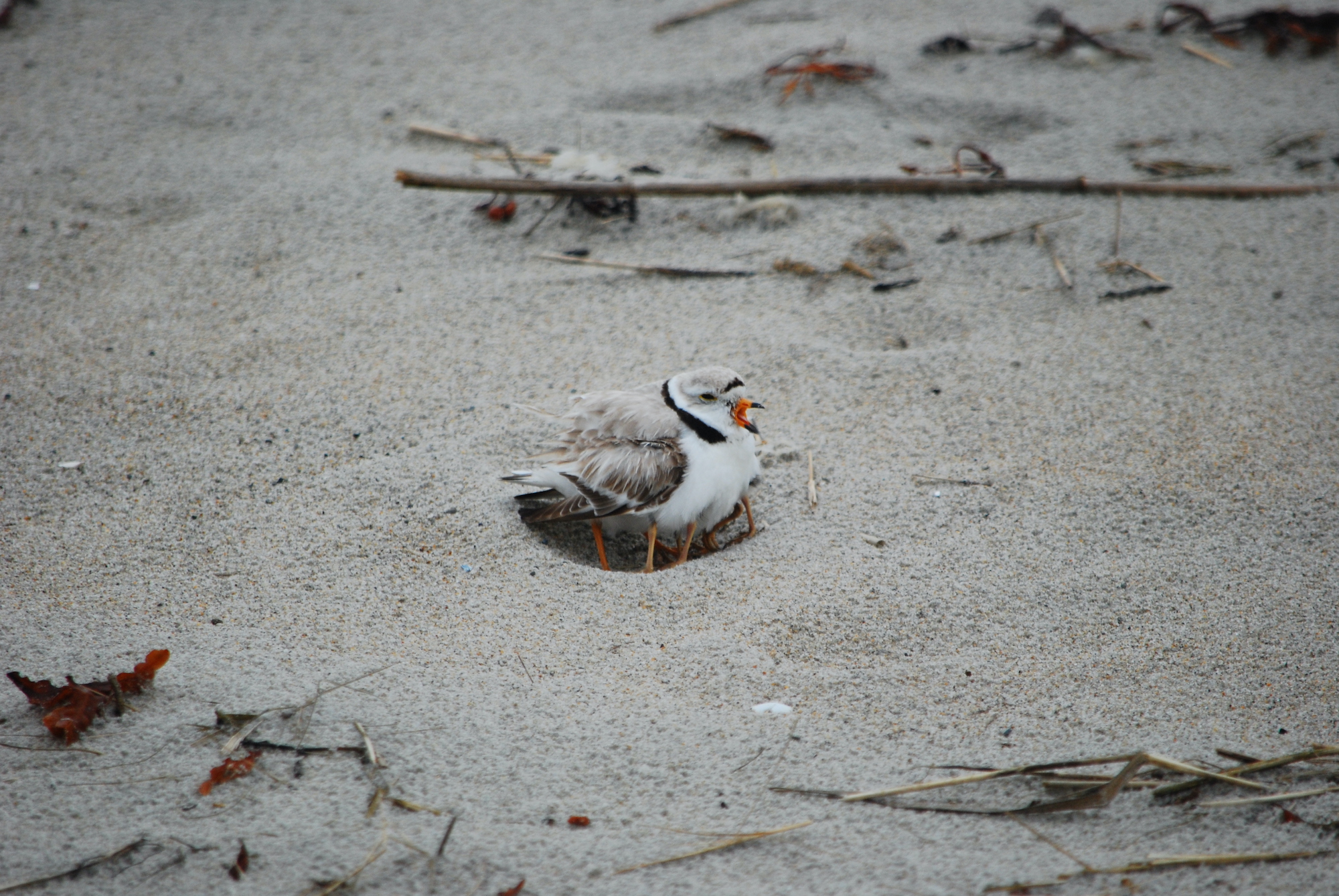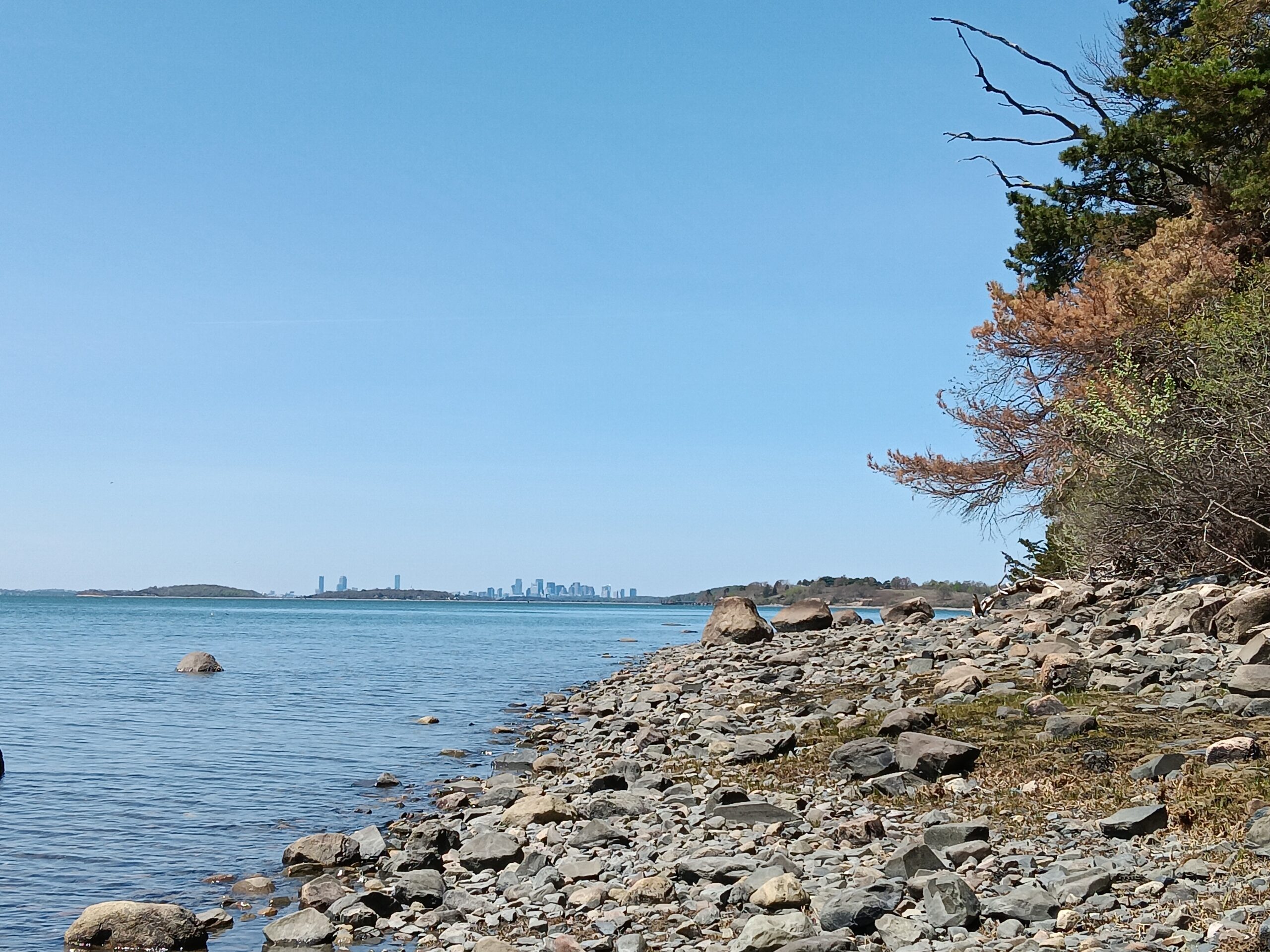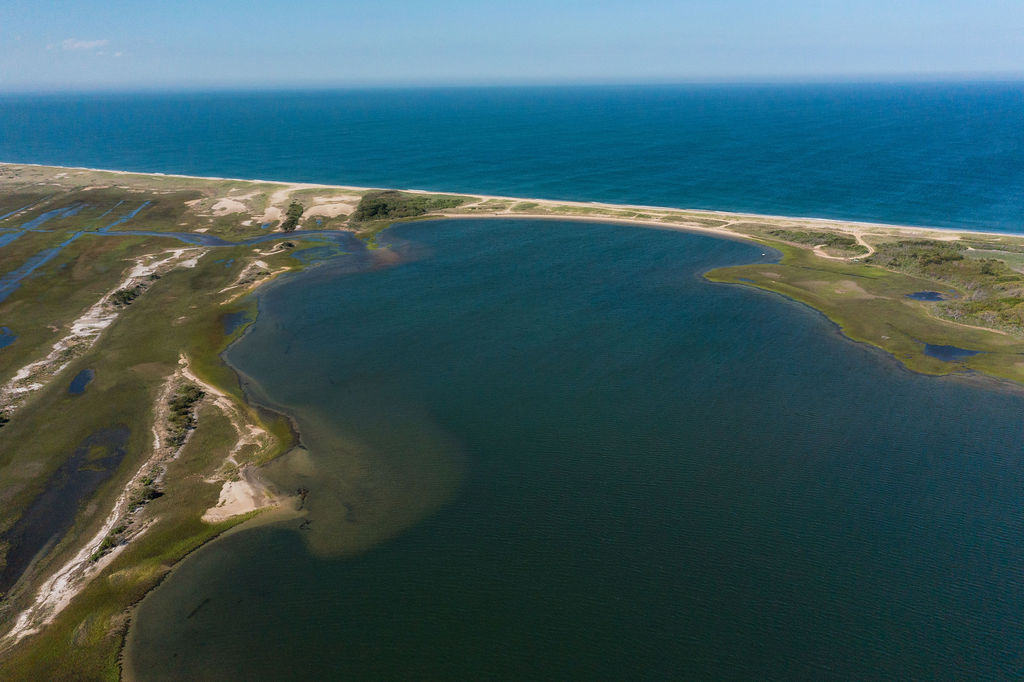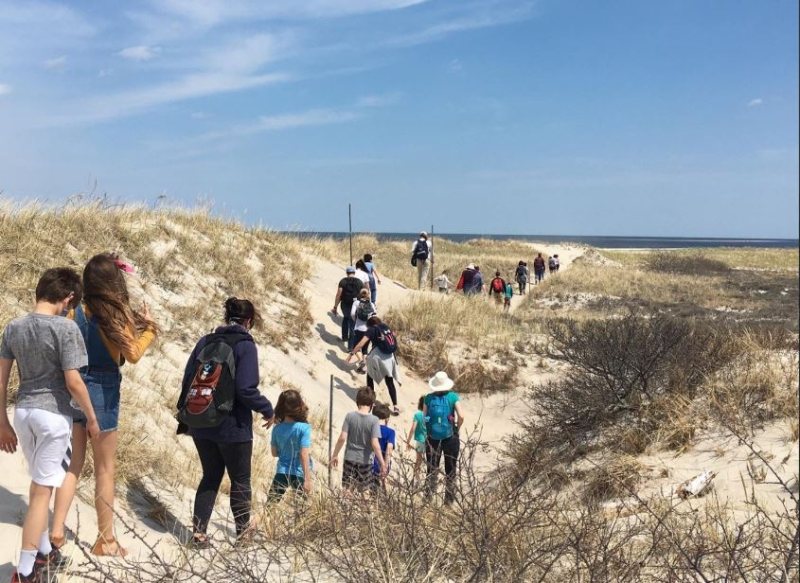Shorebirds, overall, are a class of birds experiencing large-scale global declines. As the largest private owner of protected coastline in the state, The Trustees manages our properties in a balance: For public enjoyment, and while ensuring the success of threatened species—this stewardship is part of Trustees values.
How are shorebirds protected?
All migratory birds are protected under the Migratory Bird Treaty Act and shorebird habitat is protected under State and Federal Wetlands Protections Acts. The birds actively managed on Trustees beaches include the Piping plover, American oystercatcher, Black skimmer, Least tern, Common tern, and Roseate tern. Among those species, the most abundant and consistent nesters on Trustees beaches are Piping plovers, American oystercatchers, and Least terns.
Similar to human beachgoers, our three focal shorebirds species prefer to spend their time on wide sandy beaches or sand spits with gently sloping dunes. These birds lay their extremely camouflaged eggs in shallow divots in the sand (called “scrapes”), sometimes decorated with pebbles or small shell fragments. Eggs are incubated for about one month through wind, rain, and heat until the chicks hatch.
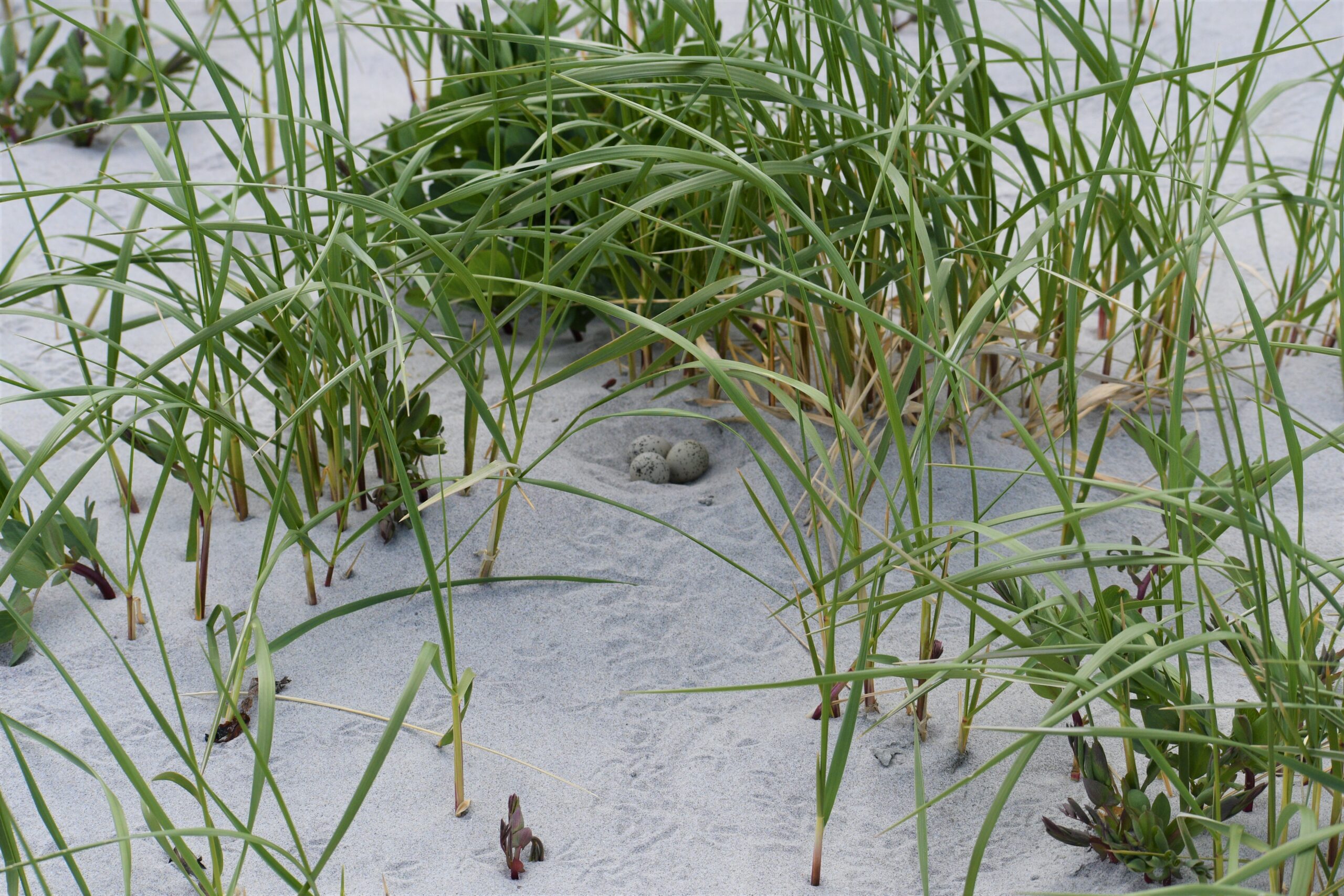
Piping plover nest
Piping plover chicks are considered “precocial,” meaning they have a full downy layer of feathers and are able to walk and feed themselves shortly after hatching. They are only about an inch and a half tall and can be seen scurrying along the wrack or waterline as they search for food supervised by their parents. American oystercatcher and Least tern chicks are what is known as “semi-precocial.” Though they are also born with a full downy layer of feathers and can walk fresh out of the egg, they rely on their parents for food. It takes roughly another month for chicks to become flight capable.
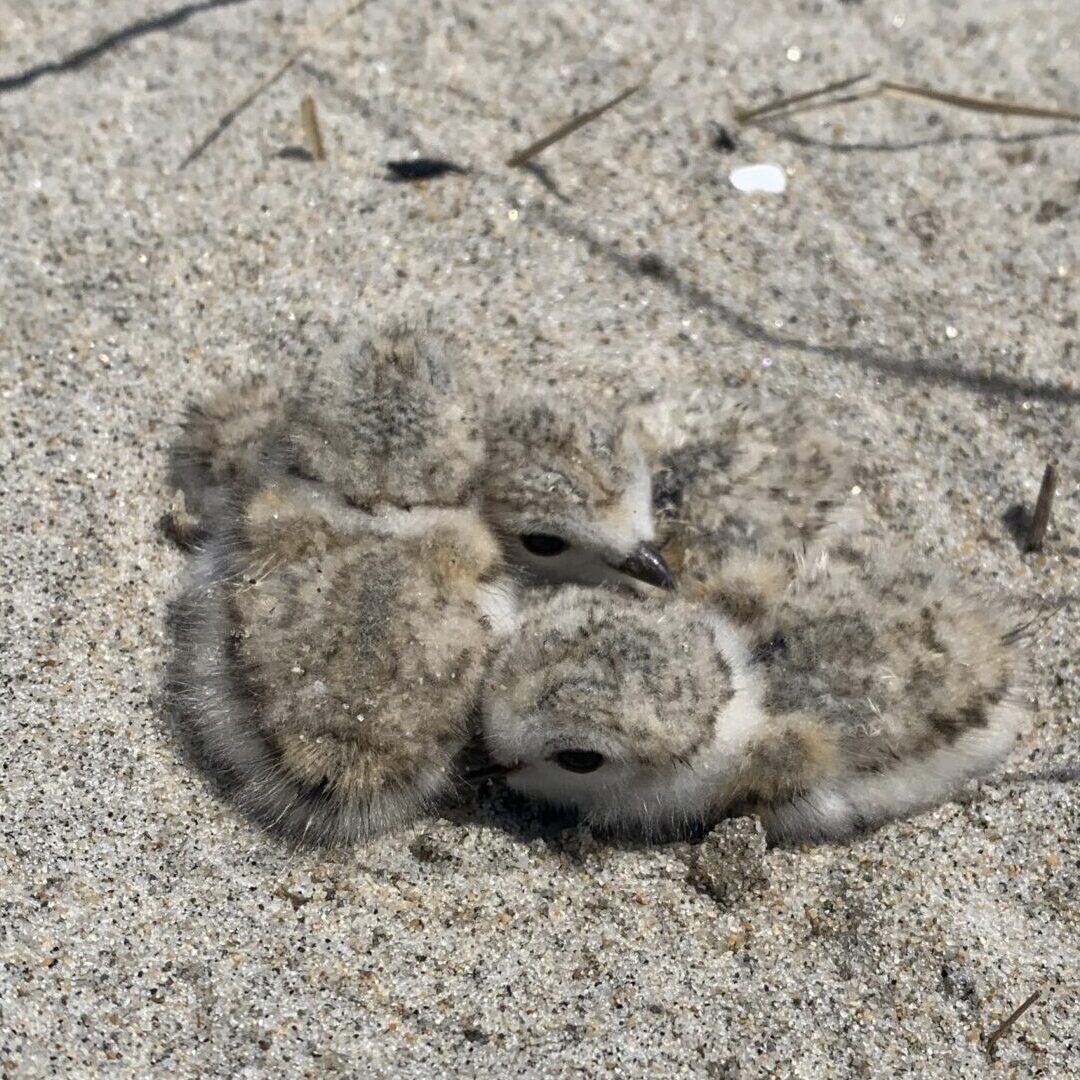
Piping plover chicks (Trustees photo)
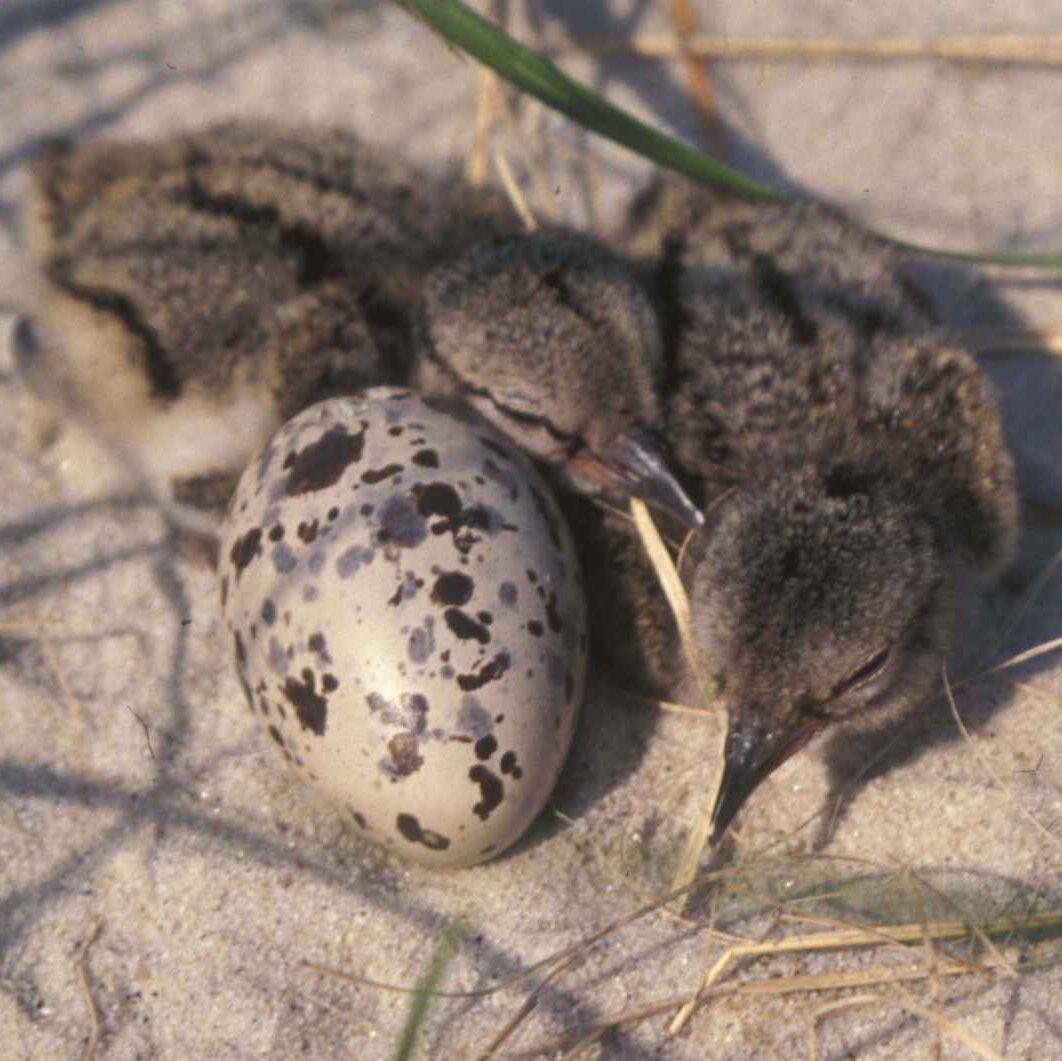
American Oystercatcher chicks (USFWS Photo)
What does it take to steward a shorebird season?
Seasonal and year-round staff work hard to keep these birds safe and document their successes and setbacks. Overall, The Trustees use guidelines developed by state and federal governments to manage our shorebirds (Massachusetts Tern and Plover Handbook: a manual for stewards and Guidelines for Managing Recreational Activities in Piping Plover Habitat on the US Atlantic Coast to Avoid Take Under Section 9 of the Endangered Species Act). Much goes into our shorebird protection program, including installing symbolic fencing before April 1 and maintaining it throughout the season, conducting intensive daily monitoring to track nesting pairs and fledglings, communicating shorebird activity and movements with beach staff, and sharing information with the public about beach nesting birds.
In summer 2022 this also included implementing the Habitat Conservation Plan (HCP) at Norton Point Beach, a state-run procedure that allows for continued OSV access while following a strict protocol designed to limit harm to the birds. This means we were able to provide continued OSV access in areas where chicks were active—areas that would otherwise be closed to OSV traffic under state and federal laws and guidelines.
At the end of each season, our local ecology staff compose detailed reports on the season for our own records, and to be submitted to the state.
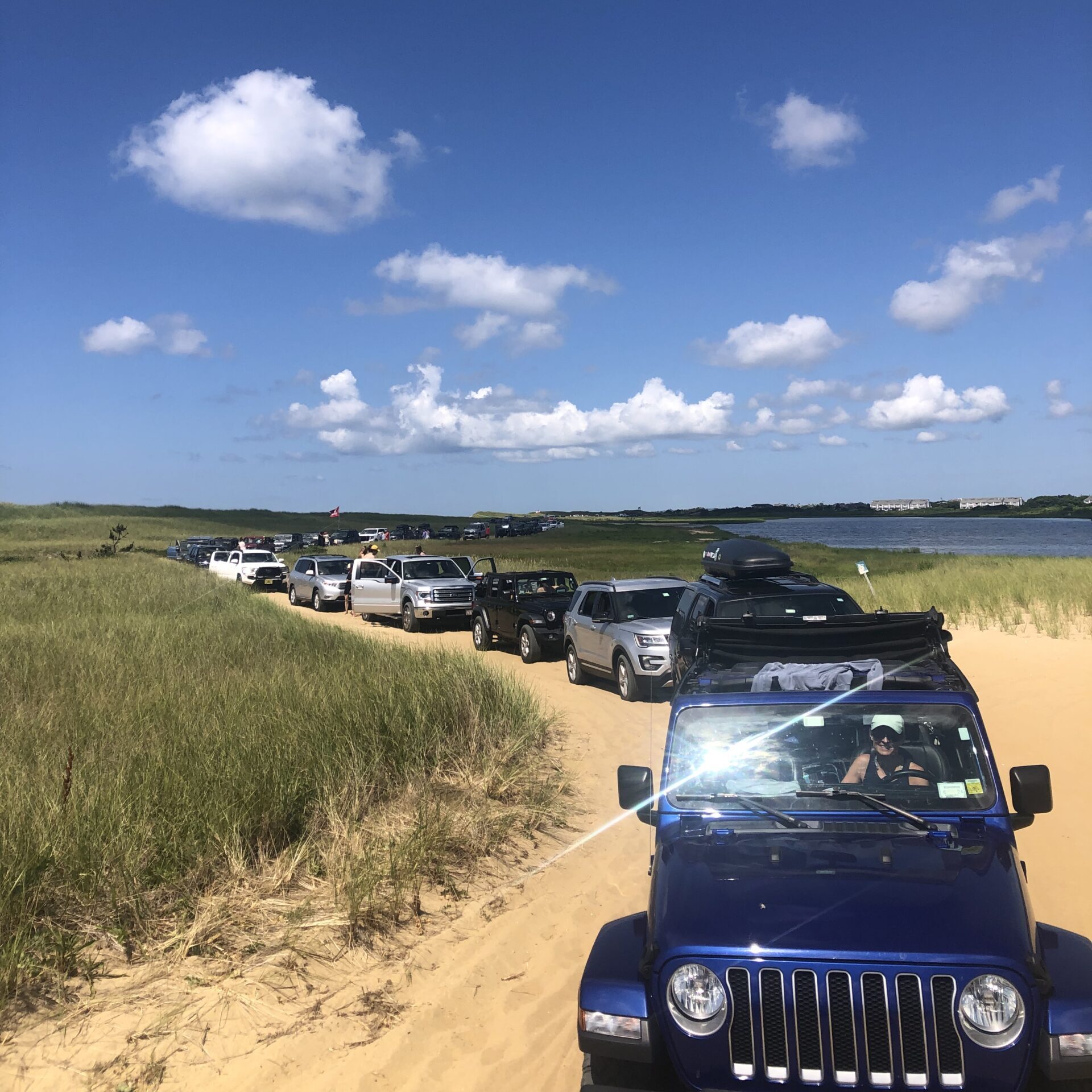
Under the HCP, Trustees staff were able to escort vehicles onto Norton Point Beach during nesting shorebird season, in areas that would otherwise be closed to OSV traffic under state and federal laws and guidelines.
Martha’s Vineyard shorebird numbers
In the summer 2022 season, a record 29 pairs of Piping plovers nested on our Martha’s Vineyard properties including Cape Poge Wildlife Refuge, Wasque Reservation, Norton Point Beach and Leland Beach, and Long Point Wildlife Refuge. This record number is part of an encouraging trend: As nesting pairs have continued to increase statewide, so do breeding pairs on Trustees beaches. This summer’s 29 intrepid pairs produced 17 fledged young, giving us a final productivity of .59 fledglings per breeding pair. While this is a significant increase in productivity from the 2021 season, it is still below the federally instituted target of 1.24 fledglings per breeding pair—a U.S. Fish and Wildlife Service benchmark number for what is required to sustain and grow a healthy population, according to intensive Piping Plover population studies. All shorebird cooperators up and down the Atlantic Coast aim for this productivity number.
While our pair numbers on Martha’s Vineyard continue to increase over the years, our productivity remains low. Nest depredation and human disturbance remain the biggest challenges. This season, 36% of Piping plover and 50% of oystercatcher nest losses were attributed to predation, including from skunks, crows, and raccoons. These three species are notorious egg lovers and can have serious impacts on ground nesting birds—especially if their populations become inflated due to a lack of natural predators, which is the case on Martha’s Vineyard.
How do these numbers compare?
To put all these numbers into an island-wide perspective, a total of 74 pairs of nesting Piping plovers were recorded on Martha’s Vineyard this summer, meaning that the Trustees properties supported 39% of the island’s overall breeding population. Similarly, 41% of the island’s 46 breeding American oystercatcher pairs chose to nest on Trustees beaches. The amount of well managed and undisturbed habitat we provide benefits an extremely significant portion of the local populations of these focal species.
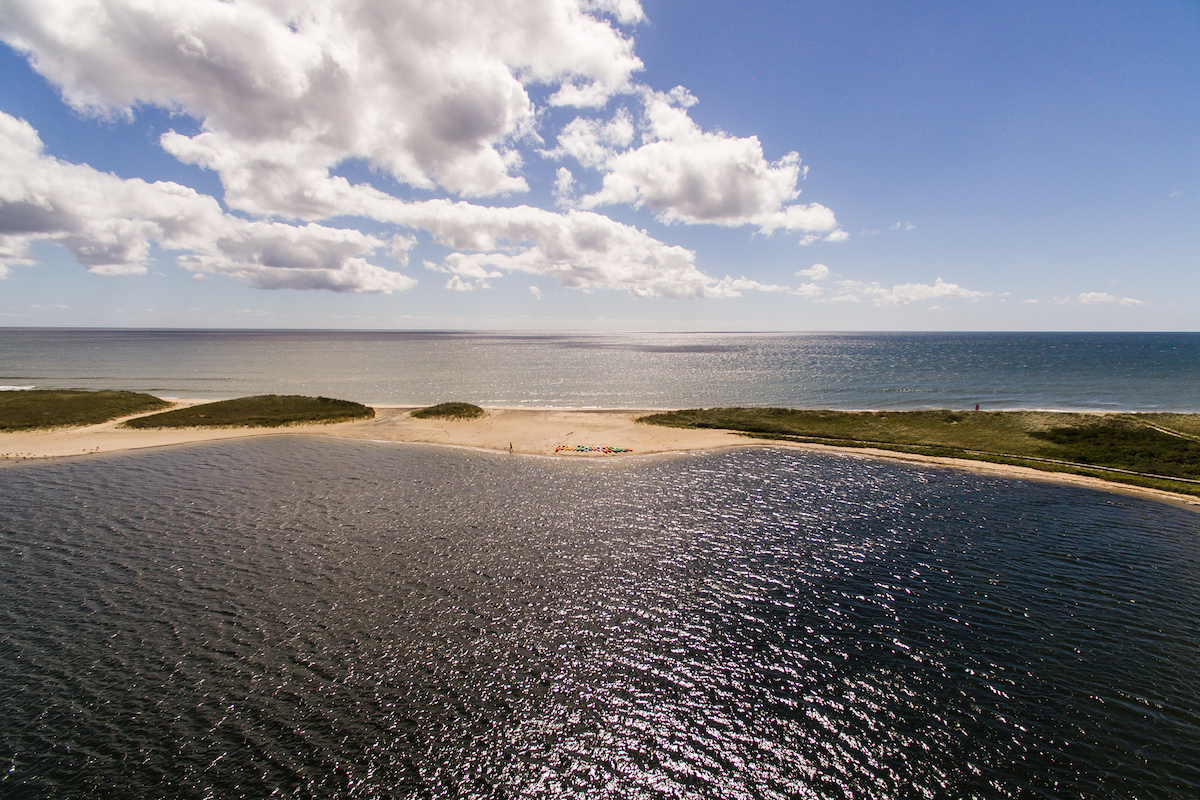
Long Point (Above Summit photo)
Shorebirds on Nantucket
The Trustees also manage shorebirds on Nantucket’s Coskata-Coatue Wildlife Refuge. This is the only Trustees property on Nantucket and is comprised of 1,100 acres of barrier beach, salt marsh, and coastal woodlands. This year, six pairs of Piping plovers, nine pairs of American oystercatchers, and 27 Least terns nested on the Refuge. While six pairs of plovers may not sound like many, this is the largest number of pairs that have nested on the property since 2015. Numbers of nesting plovers on the Refuge had been trending downward since 2015 but have since experienced a small uptick over the past two years, and were quite productive this summer—producing 7 fledglings and resulting in a productivity number of 1.15 fledges per breeding pair, a significant increase from last season. Oystercatcher pair numbers are also experiencing a gradual increase with 9 nesting pairs this season, reaching productivity goals with 5 total fledglings (.56 fledges per breeding pair).
Island-wide, Nantucket had a total population of 75 nesting Piping plover pairs, 51 American oystercatchers, and 329 nesting Least terns. The Coskata Coatue Wildlife Refuge supported 8% of the overall island breeding plover population, 18% of nesting oystercatchers, and the third largest Least tern colony on the island. Nantucket has the advantage of not having any mammalian nest predators such as skunks or raccoons. Instead, the most common cause of nest loss on this island is overwash from storms or extreme high tide events. Nantucket does however, suffer from high chick loss rates likely attributed to nearby nesting Northern Harriers or gulls.
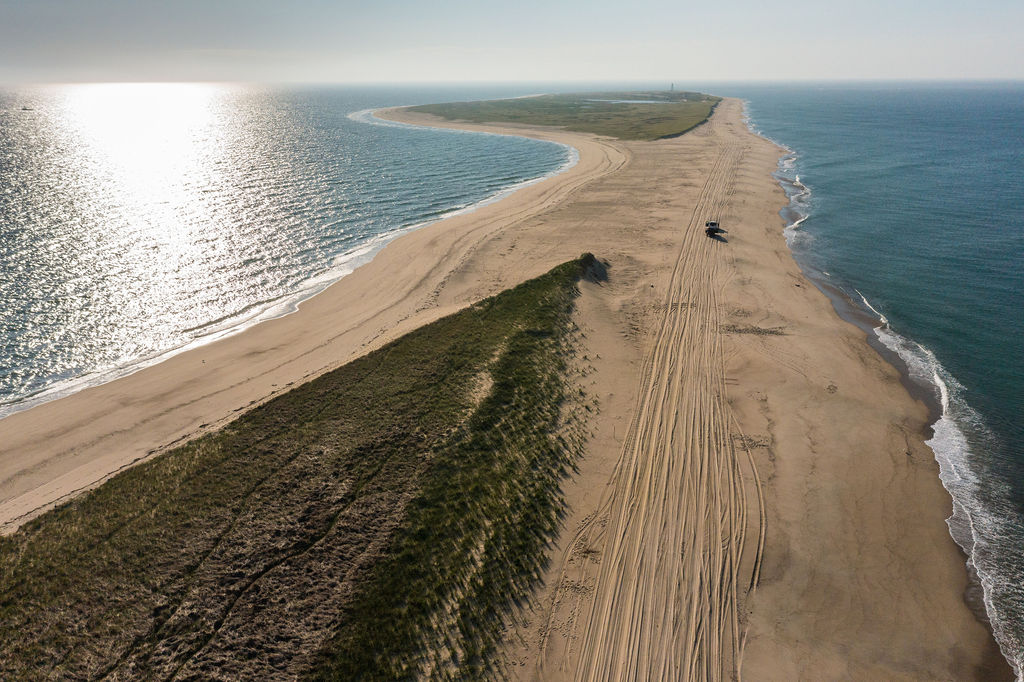
Coskata Coatue Wildlife Refuge (Above Summit photo)
National significance
Massachusetts has been enthusiastically protecting Piping plovers since 1982 and has developed some of the most successful protection guidelines and management practices in the country. In the 2022 breeding season, 970 pairs of Piping plovers nested on the shores of the bay state with a midpoint productivity of 1.25 fledglings per breeding pair. That is over half of the entire North Atlantic breeding population! Over the years pair numbers continue to increase and Massachusetts remains the stronghold for the North Atlantic population, indicating that protection efforts are working. Massachusetts also provides habitat for a whopping 212 American oystercatcher pairs and 3,161 pairs of Least terns.
Island beaches play an important role in statewide beach nesting bird populations. Together, the islands of Martha’s Vineyard and Nantucket support 15% of the state’s nesting Piping plovers, almost half of the American oystercatcher population (45%) and a quarter of the breeding Least tern population (24%). These beaches are important for the persistence of many species.
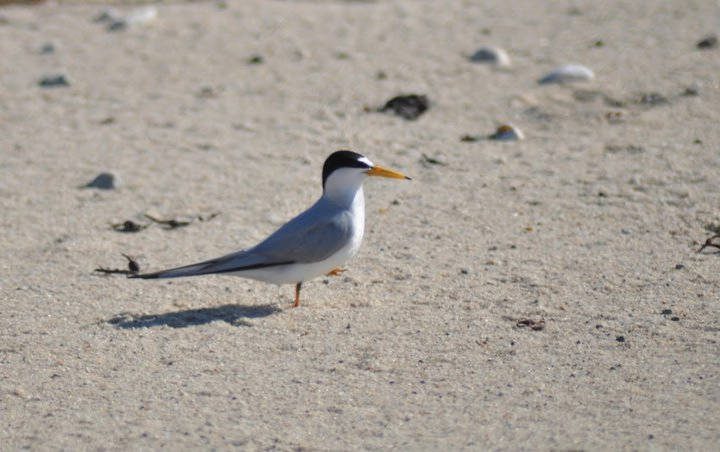
Least Tern (Amanda Boyd/USFWS photo)
The challenges faced by shorebirds & how you can help
While it is important to celebrate these birds’ successes, we must also acknowledge the growing mountain of challenges they face. More people are using the beaches than ever before, limiting the amount of undisturbed habitat available for these birds to nest and successfully rear their young. Increased rates of coastal development also plays a role in habitat loss, and an unfortunate reality of more humans on and around coastal habitats is also an increase in refuse. An excess of garbage attracts shorebird predators like raccoons and skunks and can boost their populations by providing them with a reliable food source. Climate change also poses a major threat. Rising sea levels and more frequent and intense storm events will increase the number of nests lost to overwash and lead to the ultimate steepening and narrowing of beaches.
The habitat in which these three species can live and breed is extremely limited, but Trustees beaches can help provide these birds with a safe space to rest, reproduce, and thrive. Beach nesting birds achieve incredible physical feats every year to raise a family on our shores! While Trustees staff put in a significant amount of time and effort into the shorebird protection program, it ultimately takes a village to ensure these birds’ success. The obstacles these birds face are many, but anyone can help be a part of their success in several ways, starting with understanding what these threatened species are up against and sharing the beaches. Please respect symbolically fenced areas, keep pets leashed at all times and out of shorebird areas, obey pedestrian and vehicle closures, properly dispose of trash, maintain a safe distance from any shorebirds so as not to disturb them during this critical time, and be open to learning about the journey and lives of these species. All of these considerations can go a long way towards helping to protect these important species into the future.
